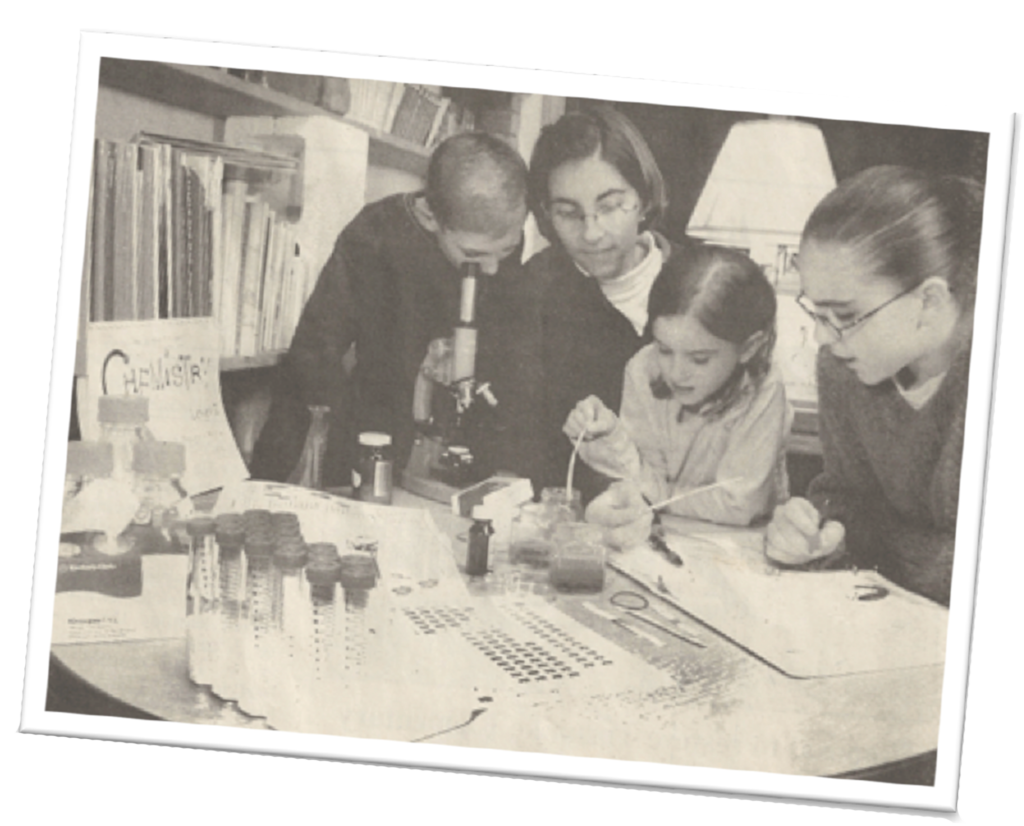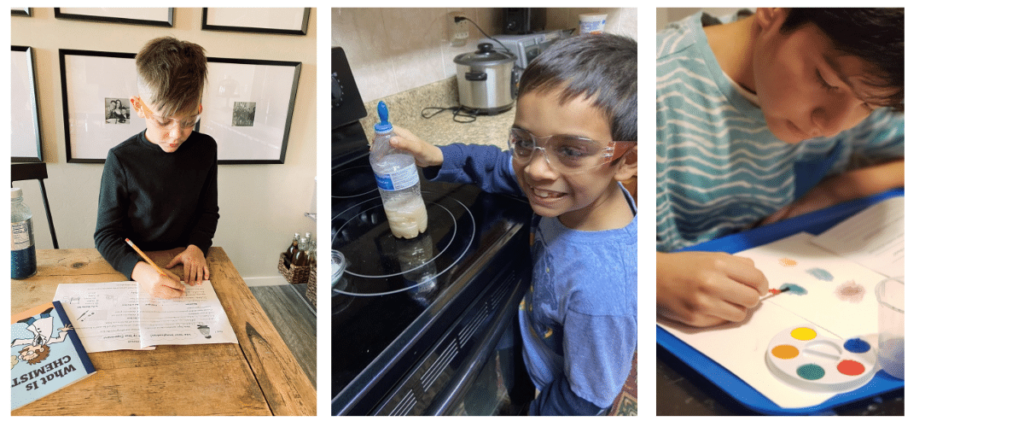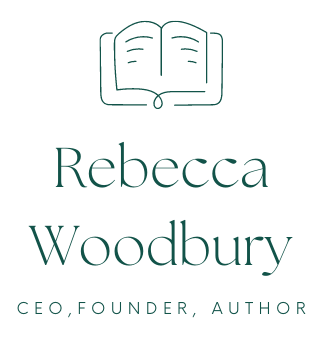“How can I bottle what I learned in grad school and give kids the tools they need to succeed in STEM fields?” Dr. Woodbury has been working on this challenge for 30 years.
I grew up in a small New Mexico town, a few hundred miles north of Texas and close to the Arizona border. I had a solid education with good teachers, supportive parents, and access to good books at home, libraries, and plenty of extra-curricular programs. I took all the advanced math and science classes available, and when I graduated, I was third in my class. My dream was to become an oceanographer. I loved the idea of sailing the open seas, saving marine life, and protecting the oceans. I didn’t become an oceanographer (it turns out I get seasick), but I did pursue a science career and earned my Ph.D. in biophysical chemistry, but getting there wasn’t easy.
I entered college confident I was ready to tackle college-level classes. I had, after all, made straight A’s in high school and scored very well on my college entrance exams. My freshman chemistry professor announced that more than two-thirds of the students would drop out by the midterms on the first day of class. I laughed at the thought. I didn’t see myself as someone who would struggle with his style and believed I could handle it until I flunked the first chemistry exam. I got a 38%, with most of the answers incorrect. I remember thinking, “well, I got my name right!” I was shocked, and all the confidence and bravado I had walked into this exam faded like a forgotten grape. I was lucky, though. I had made a friend from Los Alamos, and she tutored me. I ended up with a B in that class and graduated with honors with my bachelor’s in chemistry by my senior year. Had it not been for my Los Alamos friend, I might have dropped out of pursuing a science career altogether. Even though I succeeded, my college experience shattered my confidence, and for most of my undergraduate and even some of my graduate career, I felt far behind my peers academically.
I had forgotten mainly my early undergraduate experience when I had children of my own. When they were old enough, I wanted to teach them all I now knew and loved about science, so I started looking for science textbooks. I found a few elementary science textbooks, and flipping through them; I wondered why I flunked my first college chemistry exam. I noticed that elementary and middle school science textbooks present science as random topics with minimal vocabulary or connecting concepts.

Elementary students learn about plants, animals, and weather but nothing about atoms, molecules, and chemical reactions. Elementary students learn about light and “push-pulls” but nothing about force, energy, work, inertia, or friction. Elementary students might know that a plant needs sunlight and water to grow, but nothing about the chemistry and physics behind why that’s true.
Seeing these vast gaps in knowledge-based content, I decided to write my textbooks. I was frustrated as a parent looking for materials my kids could truly learn from and explore. This was the driving force behind the science textbook series, Real Science-4-Kids, which has actual chemistry and physics as foundational topics for young students. Tens of thousands of kids have used real Science-4-Kids for over 20 years. The books follow a logical progression from basic concepts, like atoms and molecules, to more advanced concepts, like DNA and protein structure and function.
Yet, as time went on, I felt something was still missing. I had created a solid textbook series that had plenty of basic science vocabulary, concepts, and skills. However, I still couldn’t figure out how to bottle the lessons from my graduate school experience and inspire kids to get excited about doing science.
Why RATATAZ?
When I was in graduate school, science finally came alive for me. I was finished receiving lecture-based material through the required coursework, and I no longer had to work in labs doing experiments created by laboratory notebook publishers. Graduate school was all about doing my experiments! For the first time in many years, I asked questions about the science I found exciting and designed experiments to answer those questions. In graduate school, you pick a lab to join whose scientific research seems interesting. Within the lab, the graduate advisor has several ongoing projects, and you mostly get to decide which of those projects you want to work on. You are required to come up with original research, and this can only happen if you have the freedom to ask questions that no one has yet answered. The graduate advisor guides you, but it’s up to you to figure things out. I felt like the hamster was finally off the spinning wheel, as I finally had the freedom to play, tinker, test, design, and solve excellent problems from my perspective.
How do you take that experience, package it, and turn it into something kids will enjoy that provides the real science learning kids desperately need? What exactly could I capture from my graduate school experience? It took years to see the big picture finally. The program I wanted to create started to fall into place when I took a professional education course through the Harvard Graduate School of Education. This course was about getting kids to ask and answer their questions, not just the teacher or textbook publisher’s questions. This! This is what made graduate school different than lecture-based coursework! But as I was soon to find out, getting kids (or adults) to ask their questions would be challenging.
Are you testing the idea for RATATAZ?
We decided to test-run our idea with a small group of online students. The pandemic was just in its infancy, shuttering the schools, and many kids found themselves at home, bored and slogging through onerous online programs. Through our established Real Science 4-Kids community, we recruited a group of students willing to learn how to RATATAZ. We set up 16-days worth of question-focused activities where kids were given the freedom to ask questions about the question-prompt presented to them. Because COVID-19 was on everyone’s mind, we called our program CoronaQuest, and the idea was to let the students learn anything they wanted by just asking their questions.
Initially, it wasn’t easy. No one understood exactly how this worked because kids are not taught to ask their questions, only answer the questions provided by the parent, teacher, or publisher. It went slowly at first, with some parents complaining it was too complicated, tedious, or confusing. We gave the students (and parents) hints about how to start questions, reminding them that questions begin with “What happens if..” or “How can I…” A few dropped out, and I was starting to get discouraged! But some parents let their kids struggle with the process just long enough to break through. After a few days, the students began to blossom! All sorts of questions started popping up. We instructed the parents not to answer their kids’ questions but to help them find the answers themselves through new research or with an experiment they designed and executed. The energy of our little group started to flow as more and more posts were being added with questions, drawings, and tiny experimental ideas. We then asked the students to present their results and what they learned any way they wanted to. Some students made videos with hand puppets. Some students gave lectures from flip charts. Some students created original artwork, and one student performed interpretative dance! Seeing these energized kids’ creativity, genius, and hidden talents was incredible.

I recall one student in particular. She was quiet and participated very little at the start. She didn’t want to do any videos; she didn’t want to speak on camera or share her thoughts or ideas. But she kept a keen eye on everything that her brothers were doing. On the last day, I asked all the kids to produce a video summarizing what they had learned. I was astonished when this quiet girl spoke into the camera and finished by saying, “I had the most fun I’ve ever had in the summer. And now I can ask questions like the boys.” She was dazzling, proud, beaming, and confident.
What does RATATAZ mean?
RATATAZ is an acronym and means “Read, Ask, Test, Answer, and Tazzle.” (Tazzle is a word I made up, and it means “talk, tell, and dazzle”).
RATATAZ is fun to say and easy to remember.
Educational fads come and go, and many different learning theories tend to compete for dominance. But our most incredible resource is the ability to work with opposing ideas. With this in mind, I sought to create a program that combines the best of several different and often opposite learning theories. I wanted a concrete and comprehensive program that would give kids the knowledge-base content they need in a logical, contextual framework and the liberty and freedom to ask and answer their questions about projects, problems, or phenomena they are observing in the real world. I also wanted to make sure that kids had the chance to tazzle. Tazzle is a fun way to get kids to participate in retrieval practice. When kids present what they have learned entertainingly, it helps them retain, retrieve and apply information to novel situations.
RATATAZ gives kids “real science” and encourages them to get creative, share their discoveries, and believe in their science abilities. The students who RATATAZ with us online during the pandemic shared what they learned in their own top talent dazzling manner, learning more about their specific science subjects than we could have ever taught them. It was fun, engaging, and rewarding.
I don’t think that RATATAZ is a magic bullet. It won’t fix all the problems, and some students (and teachers) might find it too different from how they are used to learning (or teaching). But RATATAZ does combine the best of several different learning theories in an easy-to-use and easy-to-remember program that will get students farther along in their abilities to remain interested in, and ultimately succeed in any subject they want to pursue. I’d like to think that students who learned how to RATATAZ in the elementary grades can one day confidently walk into their college freshmen chemistry class and ace their first exam!
